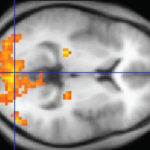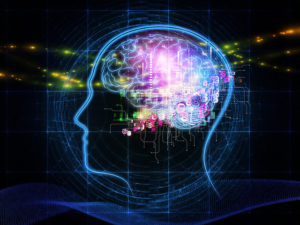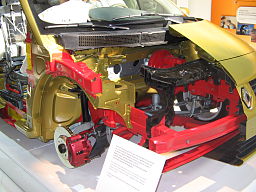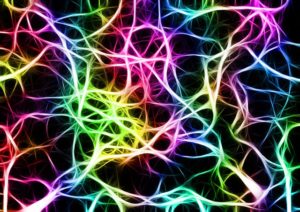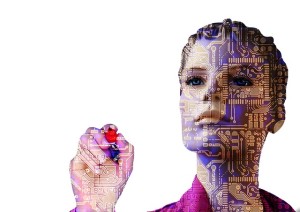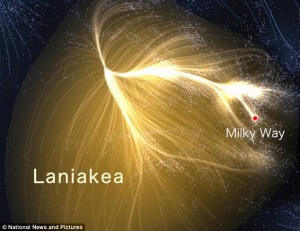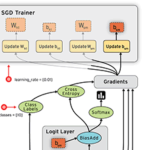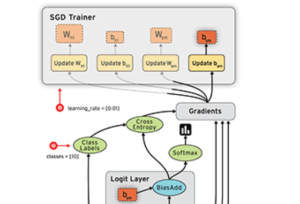I’m back with a first true post regarding a discipline that I like immensely because of its tendency to be helpful to users, customers, companies… and humanity.
Today, we will assess the advantages of recruiting cognitive science specialists. You will see that such profiles are interesting not only for research but also for companies. It’s time to consider to recruit cognitive science specialists.
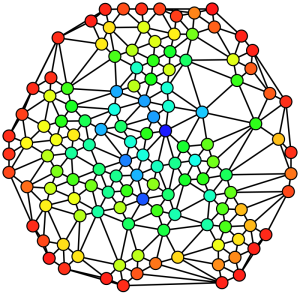
Cognitive science? eh?
You may wonder what I mean by “cognitive science”. That’s why I will explain a bit about this in fashion interdisciplinary field. Fashion in that is the “C” of the NBIC acronym which stands for Nanotechnology, Biotechnology, Information technology and Cognitive science that refers to the converging technologies (and sciences) for improving human performance.
A definition
I will first introduce a definition by Jean-Pierre Desclés:
This field is the study of the Mind in relation to its material substrate, the brain. It is understood through both the comprehension of the neurobiological aspects and the modeling of observable “intelligent” behaviors [such as perception, memory or planning].
This study of cognition, by the way of models (logical, mathematical, probabilistic and computer/information model) encompasses the mind-brain relations not only in humans but also in animals and complex computers […].
In a broader way, I would define the cognitive science as the study of the cognitive processing of information (according to the prevailing information paradigm), in either natural or artificial systems.
A little bit of history
Disclaimer: This section is related to history of science and can easily be skipped… but at the cost of lacking of some interesting deeper understanding of the essence of cognitive science!
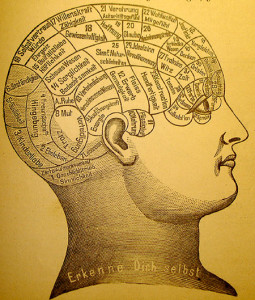
This field, by nature interdisciplinary, developed through 3 ages and their respective complementary paradigms:
Cybernetics and the formalisation of the “self” idea, from the Macy’s conferences (1946-1953) is the starting point of cognitive studies. It “studies the flow of information in complex artificial systems and natural ones”.
Followed by cognitive science emergence in reaction to the “black box model” of behaviorism (where “psychology can be accurately studied only through the examination and analysis of objectively observable and quantifiable behavioral events, in contrast with subjective mental states“):
- Cognitivism (top down approach) and the introduction of two work hypothesis (representationalism and computationalism), 1950-1980 – “the thought is a symbolic process and knowledge is readily shifted between different memory registers”
- Connectionism (bottom up approach), which models mental states as the emergent processes of interconnected networks of simple processing units, early 1980 – knowledge is represented in the weights of the connections between neurons and is shaped by weighting during learning
- Embodied cognition where “Many features of cognition are embodied in that they are deeply dependent upon characteristics of the physical body of an agent” (RA Wilson and L Foglia, Embodied Cognition in The Stanford Encyclopedia of Philosophy) … grounded in an environment – “the mind and body work together to form cognition”
I must confess, this description of the evolution is, on purpose, simplistic. Actually it is far more complicated with mutual feedback loop, co-occurence of paradigms, origination from several other theories like structuralism, mediated reference theory and many more. If it was so simple it would not be studied as a standalone speciality!
5-keys insights
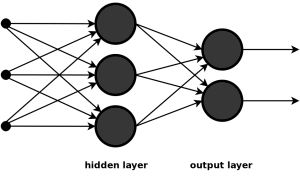
To summarize, in his book The Blank Slate (2002), psychologist Steven Pinker identified five key ideas that made up the cognitive revolution:
- “The mental world can be grounded in the physical world by the concepts of information, computation, and feedback.”
- “The mind cannot be a blank slate because blank slates don’t do anything.”
- “An infinite range of behavior can be generated by finite combinatorial programs in the mind.”
- “Universal mental mechanisms can underlie superficial variation across cultures.”
- “The mind is a complex system composed of many interacting parts.”
Interdisciplinarity required
From the early stages of its precursor cybernetics, the interdisciplinarity is inherent to the cognitive science. Since its emergence, the field strengthened relations between several fields and generated new topics of research to in fine create new relations between distant fields.
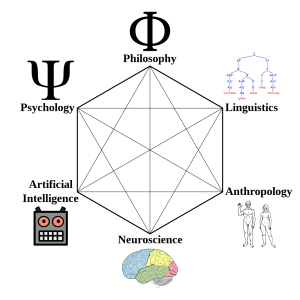
At the academic level, cognitive science is constituted of legacy core disciplines those are:
- analytic philosophy
 of language
of language of mind
of mind- epistemology
- psychology
- cognitive ψ
- engineering ψ
- linguistics
- psycholinguistics
- cognitive linguistics
- transformational grammar
- …
- neuroscience (not only computational)
- artificial intelligence
- anthropology
At all levels, the use of formal sciences for description, modeling and simulation (i.e. logic, mathematics, computer science) is compulsory.
In addition to the prominent use of bayesian inference, I should point out the emergence of a bayesian cognitive science where cognitive systems are assumed to behave like rational Bayesian agents in particular types of tasks : “The Bayesian approach assumes that cognition is approximately optimal in accord with probability theory” (Thagard, Paul, Cognitive Science in The Stanford Encyclopedia of Philosophy (Fall 2014 Edition)).
Depending of the topic, more fields can be adjoined such as ethology, information science or educational sciences.
Applied cognitive science
Since its main subject is the study of information processing in either artificial or natural systems, the applications are infinite in this informational world (even intrinsically)!
You may now suppose that fields of application range from improving the coupling between humans and artificial systems to sensory substitution and you are (almost) right.
Professional areas
Actually, cognitive science specialist can encompass careers not only in:
- Data/Information representation, filtering and retrieval
- semantic Web
- recommender systems
- human-computer information retrieval
- …
- Intelligence analysis (in order to help to make key business decisions through the use of description, modeling and prediction)
- behavioral analytics
- customer analytics
- business intelligence
- Computer-human interaction and human factors (for a better experience and efficiency at using services)
- interaction design
- User eXperience design
- information architecture
- Multimedia design and multimodal interaction
- Artificial intelligence
- Web intelligence
- ambient intelligence
- robotics
- …
- Natural Language Processing
- text mining
- speech recognition
- …
But also in deviated fields:
- Knowledge engineering and knowledge management
- expert systems to help doctors
- enterprise collaboration systems
- …
- Public health and pharmaceutics
- behavioral neuroscience in preclinical studies
- biostatistics
- Social intervention and remediation
- Education
- innovative teaching
- serious games
- e-learning
- …
- Innovation
- for instance by applying:
- C-K theory of creativity
- along with their mediation and catalyst skills
- Science journalism
And much more!
Effectiveness & efficiency enhancement
Another thing I should mention is that such professional profiles are especially valuable in either industry or professional services company. For instance, a cognitive science specialist would make an excellent (techno) functional business analyst in a standard company.
In a well-suited environment, the point is that the cognitive science specialist has the ability to improve both the creativity process and the project efficiency. User-centered design (design thinking, …) allows one to design efficiently. By means of considering human needs at each stage of a project, such specialists reduce the risks of taking the wrong turn (leading to cost overruns).
Skills
Let’s tackle the most awaited part of this article!
Due to the diversity of academic curriculum, cognitive scientists and analysts may develop diverse skills. One professional who had a major in cognitive science may become specialized in recommender systems when another may be a specialist in Natural language processing.
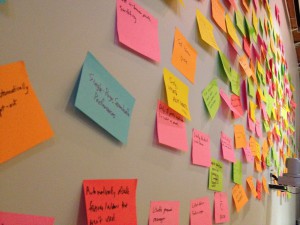
Specialization apart they share a common set of skills which is, by itself, uncommon right out of university:
- Technical background
- Analysis skills
- Excellent reading comprehension, writing, and speaking skills
- Talented at evaluating and interpreting ideas
- Skills at explaining complex scientific research
- Formalization skills
- Skills at acquiring data, modeling and predicting
- Ability to solve problems through the use of formal methods (statistics, logic, …)
- Strong interdisciplinarity
- Ability to act as catalysts of problem solving and innovation
- Ability to act as mediators in teams
- Ability to perform problem management
- Project management and decision-making skills
- Understanding of human needs in multiple professional areas
As you may conclude, such professionals acquired a specialized theoretical and practical background with a set of well-developed professional skills which allow them to hold critical and leading positions in teams.
With them, your business efficiency will improve and either users or consumers will enjoy a valuable experience.
Sounds interesting, right? Why don’t you try to hire several cognitive science analysts or project manager?
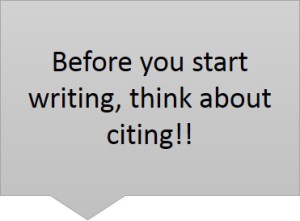
I hope you really enjoyed this first article. See you soon for a new article.
